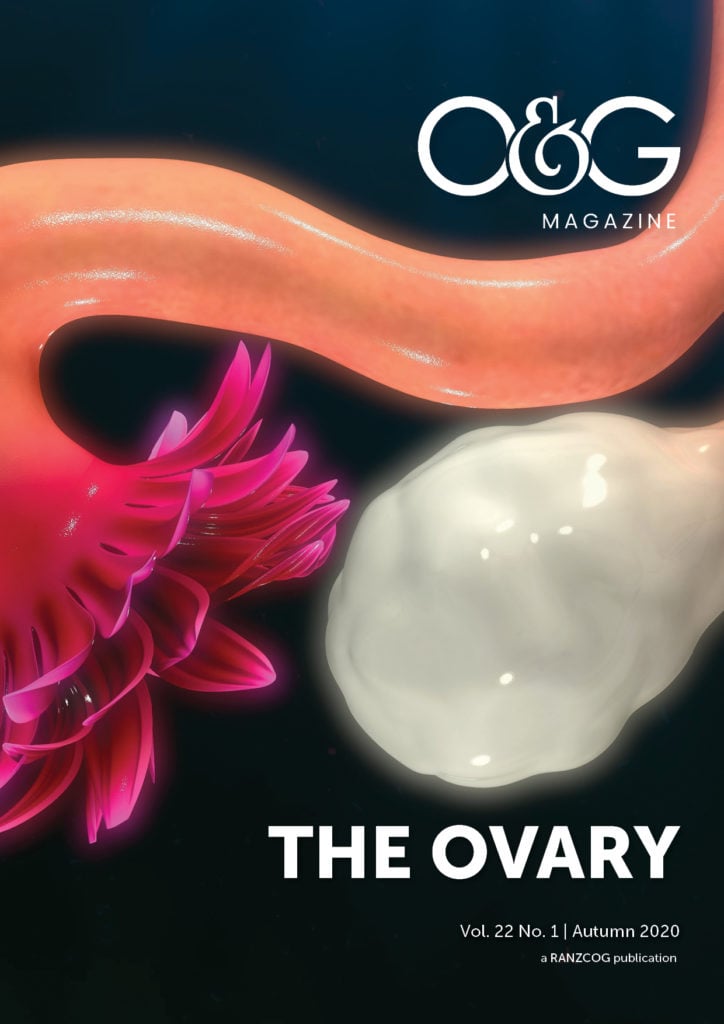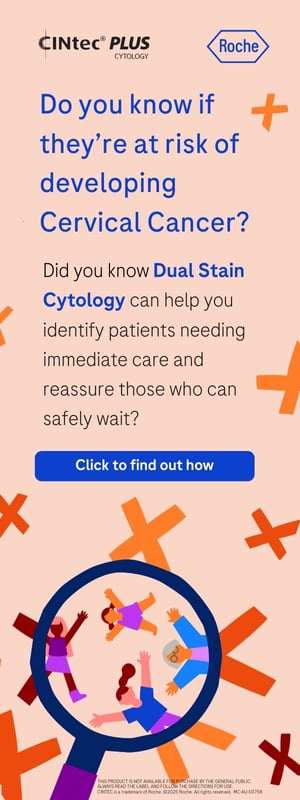Ovarian cancer is common and, in 2015, 1365 Australian and 366 New Zealand women were diagnosed with ovarian cancer, accounting for 938 and 228 deaths in 2016 respectively. Unfortunately, no effective screening strategies exist, and most women present at an advanced stage, with an 80% risk of recurrence, usually followed by multiple courses of chemotherapy and, ultimately, life-limiting disease.
For the past two decades, standard primary therapy has consisted of surgery combined with a chemotherapy regime of platinum and taxane. More recently, improvements in the management of ovarian cancer include access to tertiary level care, a more radical approach to surgery, targeted agents such as PARP-inhibitors and bevacizumab and a more aggressive approach in managing recurrence. As such, women are living longer, and in 2011–2015 the estimated five-year overall survival in Australia was 46% compared with 36% in 1986–1990; for those with early-stage disease five-year overall survivals are around 80%. Given this, ovarian cancer fits the criteria of a chronic disease and it should be managed as such, where focus of treatment includes both the initial presentation of disease and survivorship care.
With this in mind,one of the current challenges in ovarian cancer management is to not only extend life expectancy but to also improve quality of life (QoL). This involves the careful personalisation of treatment ensuring patients have access to therapies that will benefit them while avoiding interventions that will be of little benefit but reduce their QoL. For most patients, there are many such decisions around this that have to be made over the course of their disease. Unfortunately, in many of these situations, it is difficult to predict the outcome of individual interventions and these uncertainties need to be carefully discussed.
Regarding primary treatment, surgical resection aiming for no residual macroscopic disease is the gold standard as residual disease after surgery significantly effects prognosis.1 With this in mind, in recent years neo-adjuvant chemotherapy (NACT) followed by interval debulking surgery (IDS) in advanced disease has been proposed as an alternative standard of care as it significantly reduces surgical morbidity.2
This is based on the findings of two randomised controlled trials showing comparable progression free and overall survival in women with upfront versus IDS. However, the jury is still out for some as questions raised, specifically in relation to the surgical quality of these studies, make some clinicians dubious about whether this should be considered standard of care for all patients with advanced disease just yet. This question is hoped to be answered by the TRUST study (trial on radical upfront surgery in advanced ovarian cancer), which has finished recruitment with results expected in 2024.
Other important considerations surrounding primary surgery include preoperative counselling regarding the radicality of surgery, as this is increasing on the global stage and more radical surgery is associated with greater morbidity and longer recovery times, and may not be appropriate in some patients. Important factors to discuss include bowel resection and stoma formation and in some cases, women may flatly refuse to have a stoma, which can lead to suboptimal resection. More recently, ultraradical peritonectomy surgery is gaining popularity, which when coupled with heated intraperitoneal chemotherapy has shown promise, but is associated with significant morbidity. It should also be noted that while on average women who have surgery do better than those who do not, some women for whom optimal debulking will not be achieved may not benefit and hence careful patient selection for surgery is imperative.
Other important considerations for primary surgery are those surrounding younger women with early-stage disease, as traditional surgery has huge impacts on QoL including a loss of fertility. Pleasingly, research has shown that fertility sparing surgery (FSS) is safe and feasible for select patients (serous stage IA grade I or II and stage ICI grade I) and this should be discussed with this cohort of women.3 Other considerations include surgical approach (minimally invasive versus laparotomy) as the risk of cyst rupture and the subsequent consequences on adjuvant therapy recommendation need to be weighed up against the known consequences on body image that a midline laparotomy scar carries, in addition to increased surgical morbidity.
Following on from surgery comes recovery and the consideration of recovery times when planning a woman’s surgery and its radicality, particularly in the setting of advanced disease, is an important aspect of treatment planning for several reasons. Firstly, prolonged recoveries will translate to more of a woman’s limited life expectancy being medicalised, which understandably reduces QOL. In addition to this, the commencement (or recommencement) of chemotherapy may be delayed by prolonged recoveries and subsequently impact prognosis. This reiterates the point that if a surgery will not improve a woman’s prognosis, survival or QOL, it is inappropriate, and comprehensive discussions need to be had with women and their caregivers in these situations.
Unfortunately for most women with ovarian cancer, primary treatment is just the tip of the iceberg of their journey and, following its completion, women are likely to experience a wide range of sequalae that often persist throughout their lives and negatively impact their QoL. Additionally, the increasing use of maintenance therapies to improve disease free survival, which in themselves have side effects (which may include a financial burden) now need to be considered. Hence, implementing individualised survivorship programs is a crucial component of managing women with ovarian cancer.
Key to any survivorship program are regular clinical reviews assessing for treatment side effects, general and psychological wellbeing, in addition to looking for evidence of recurrence. Additionally, regular surveillance enables us to address general health promotion including maintaining a healthy BMI, regular exercise and tobacco cessation; all of which are associated with better outcomes for gynaecological cancer survivors.4
Treatment side effects often include lymphoedema, bowel and bladder dysfunction, pain and chemotoxicity (particularly cognitive impairment and neurotoxicity) and fatigue.5 When considering neurotoxicity specifically, it is common and occurs in up to 57–83% of women treated with paclitaxel.6 It can be very debilitating, manifesting with acute pain syndromes, numbness, tingling and sensory disturbance. Sadly, we do not have strong evidence regarding effective prevention strategies and treatment is very challenging, which is compounded by the fact that it not only negatively impacts QoL, but is a common reason for chemotherapy dose reduction, which in turn can worsen prognosis, making it a significant challenge for women and their caregivers.
Not surprisingly, psychological distress is also very common, with depression and anxiety present in 25% and 40% of women respectively.7 8 Additionally, post-traumatic stress disorder affects up to one third of women with advanced gynaecological cancers.9
Exacerbating these problems are stressors such as feelings of isolation, strains on intimate relationships and worries about passing on a genetic predisposition to disease.10 Additionally, the financial sequelae of a cancer diagnosis coined ‘financial toxicity’ can be crippling, with 25% of cancer survivors in Europe being quoted to live in poverty two years post diagnosis compared with just 14% of the general population.11 Given ovarian cancer commonly effects women who are still working, and a diagnosis often heralds the end of their working lives, the financial toxicity of the disease should not be underestimated as it perpetuates its psychological sequalae.
From this, it is clear that being aware of, and screening for, psychological stressors in survivorship programs is essential and initiating interventions via a multidisciplinary approach (with the support of psychologists, social workers, sexual and spiritual health consultants) in addition to addressing any treatable contributing physical symptoms, is prudent in these women’s follow-up. Interventions include things such as optimising a patients physical health (exercise, BMI and tobacco cessation) and utilising pharmacological agents (SSRIs and SNRIs) where appropriate.12
In addition to, and often exacerbating, the negative psychological sequalae, an ovarian cancer diagnosis often has negative psychosexual consequences, inclusive of a loss of ‘womanhood’, infertility, iatrogenic menopause, body image disturbance and sexual dysfunction (encompassing arousal, sexual interest, pain and orgasm).13
Infertility is obviously a devastating consequence of treatment for some women and fertility-sparing options should always be considered in treatment if possible. In addition to this, iatrogenic menopause can be more abrupt, intense and prolonged than the natural menopause and, if not appropriately managed, leads to reduced QoL, physical function and sexual desire.14 Compounding the issue is the pharmacological limitations in its management, often limited to lifestyle modifications, cognitive behavioural therapy and non-hormonal therapies.15
Sexual dysfunction and a loss of ‘womanhood’ should not be underestimated as it is reported in up to 90% of gynaecological oncology patients.16 Surprisingly, despite the staggering prevalence, 64% of patients have never had these issues addressed, although 74% of women have a strong desire for these discussions; which, ideally, should start prior to treatment.17 Potential reported barriers include time and financial resources, physician discomfort and the belief that older women may not see sexual health issues as an important component of their care; which is categorically untrue, given published data shows the majority of older adults (57–85 years) are sexually active and regard sexuality as an important part of their QoL.18
Sadly, the conclusion of many women’s ovarian cancer journey is relapse and most will succumb to their disease, making the provision of palliative care an important aspect of their journey. Common problems facing women at the end of life include pain, nausea and vomiting, hydration and nutrition, constipation and bowel obstruction, ascites and breathlessness. Managing these physical symptoms and providing support for psychological and spiritual needs is important and should extend to the woman’s family. Timely discussion regarding the role of palliative care with patients and their families is essential in order to minimise distress and empower the patient.
In conclusion, a diagnosis of advanced ovarian cancer is essentially one of a chronic and life-limiting disease. Given this, we must consider not only its initial treatment but also a woman’s journey after surgery in its management. For myself and my colleagues, we find that one of the most humbling and privileged aspects of our job is supporting these brave and resilient women throughout their journey, as despite the huge physical, psychological and psychosocial stressors, many women find that their spirituality and connection with loved ones strengthens throughout. It is our job to support and care for these women and their families and to address as best we can the multifaceted consequences that a diagnosis of ovarian cancer has on their lives.
References
- Mahner S, Trillsch F, Chi D, et al. Neoadjuvant chemotherapy in ovarian cancer revisited. Ann Oncol. 2016;27 Suppl 1:i30-i32.
- Mahner S, Trillsch F, Chi D, et al. Neoadjuvant chemotherapy in ovarian cancer revisited. Ann Oncol. 2016;27 Suppl 1:i30-i32.
- Bentivegna E, Gouy S, Maulard A, et al. Fertility-sparing surgery in epithelial ovarian cancer: a systematic review of oncological issues. Ann Oncol. 2016;27(11):1994-2004.
- Campbell G, Thomas TH, Hand L, et al. Caring for Survivors of Gynecologic Cancer: Assessment and Management of Long-term and Late Effects. Semin Oncol Nurs. 2019;35(2):192-201.
- Campbell G, Thomas TH, Hand L, et al. Caring for Survivors of Gynecologic Cancer: Assessment and Management of Long-term and Late Effects. Semin Oncol Nurs. 2019;35(2):192-201.
- Velasco R, Bruna J. Taxane-Induced Peripheral Neurotoxicity. Toxics. 2015;3(2):152-69.
- Campbell G, Thomas TH, Hand L, et al. Caring for Survivors of Gynecologic Cancer: Assessment and Management of Long-term and Late Effects. Semin Oncol Nurs. 2019;35(2):192-201.
- Ahmed-Lecheheb D, Joly F. Ovarian cancer survivors’ quality of life: a systematic review. J Cancer Surviv. 2016;10(5):789-801.
- Campbell G, Thomas TH, Hand L, et al. Caring for Survivors of Gynecologic Cancer: Assessment and Management of Long-term and Late Effects. Semin Oncol Nurs. 2019;35(2):192-201.
- Campbell G, Thomas TH, Hand L, et al. Caring for Survivors of Gynecologic Cancer: Assessment and Management of Long-term and Late Effects. Semin Oncol Nurs. 2019;35(2):192-201.
- Campbell G, Thomas TH, Hand L, et al. Caring for Survivors of Gynecologic Cancer: Assessment and Management of Long-term and Late Effects. Semin Oncol Nurs. 2019;35(2):192-201.
- Campbell G, Thomas TH, Hand L, et al. Caring for Survivors of Gynecologic Cancer: Assessment and Management of Long-term and Late Effects. Semin Oncol Nurs. 2019;35(2):192-201.
- Harris MG. Sexuality and Menopause: Unique Issues in Gynecologic Cancer. Semin Oncol Nurs. 2019;35(2):211-6.
- Huffman LB, Hartenbach EM, Carter J, et al. Maintaining sexual health throughout gynecologic cancer survivorship: A comprehensive review and clinical guide. Gynecol Oncol. 2016;140(2):359-68.
- Harris MG. Sexuality and Menopause: Unique Issues in Gynecologic Cancer. Semin Oncol Nurs. 2019;35(2):211-6.
- Huffman LB, Hartenbach EM, Carter J, et al. Maintaining sexual health throughout gynecologic cancer survivorship: A comprehensive review and clinical guide. Gynecol Oncol. 2016;140(2):359-68.
- Huffman LB, Hartenbach EM, Carter J, et al. Maintaining sexual health throughout gynecologic cancer survivorship: A comprehensive review and clinical guide. Gynecol Oncol. 2016;140(2):359-68.
- Huffman LB, Hartenbach EM, Carter J, et al. Maintaining sexual health throughout gynecologic cancer survivorship: A comprehensive review and clinical guide. Gynecol Oncol. 2016;140(2):359-68.







Leave a Reply